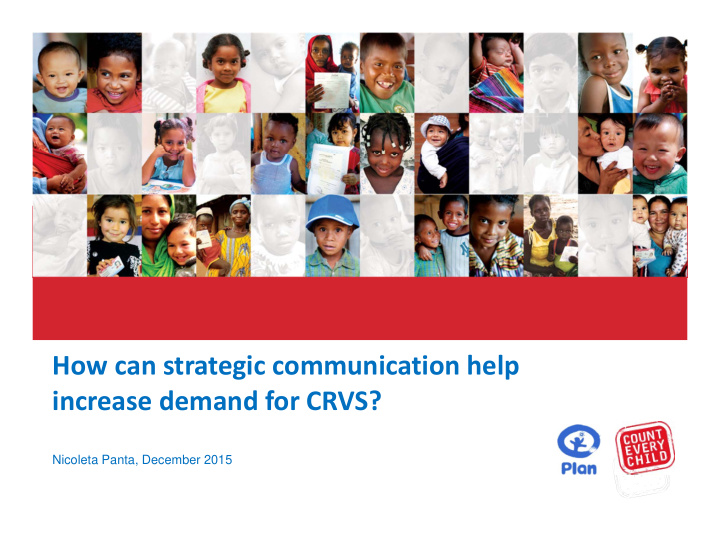



How can strategic communication help increase demand for CRVS? Nicoleta Panta, December 2015
What is Civil Registration and Vital Statistics?
Creative task 1 What do you mean when you say “I want my child to be happy”?
Action area 4: public engagement and demand creation What can we do? • One CRVS comprehensive assessment • One CRVS multi ‐ stakeholder working group • One CRVS plan of action And every CRVS plan under Action area 4 will have a one CRVS national strategic communication plan as a key element
What do we mean through strategic communication? We mean CRVS communication programms that: 1. are not just focusing on raising awareness and informing people but convincing people to make the effort, take the time and act –change but also (VIP) maintain their new behaviour 2. are planned and designed involving all national CRVS stakeholder but also development partners and private sector 3. are implemented at the National Level using evidence based communications methodologies such as Communication for Behavioural Impact
What is COMBI? • 50 YEARS OF TRADITIONAL HEALTH PLUS 100 YEARS OF PRIVATE COMMUNICATION SECTOR MARKET RESEARCH AND CONSUMMER COMMUNICATION PLUS Behaviour as the ultimate IEC and Advocacy goal Need for information, Directed at mobilizing all education, community involvement, mobilized societal and personal society, committed influences on prompting the government target group to take a specific action. PLUS Consumer sensibility Educational sensibility Value vs. “Burden” Needs (or wants or desires) It is social mobilization with a ‘behavioural bite’
The five integrated communication actions areas Public Relations / Advocacy / Administrative Interpersonal Mobilization communication / Counseling / Personal Selling Community Mobilization Someone DOING something Point ‐ of ‐ Service Promotion Sustained Appropriate Advertising
COMBI in Action Lymphatic Filariasis Dengue Fever Leprosy Tuberculosis Malaria HIV/AIDS Other Ukr Ukraine Kazakhst Kaz khstan an Albani Al bania Moldova Mol dova Bahamas Bahama Afghanistan Afghan Bangl Banglade adesh sh Domi Domini nican Republ can Republic Nepal Nepal Cuba Cuba St. Luci St. Lucia Myanmar Myanmar Hondura Honduras Belize Beli ze Barbado Barbados India Indi Laos Laos Burki Burkina Faso na Faso Philipp Ph ilippine nes Guate Guatemal ala Panama Panama Trin inid idad Sudan Sudan Thailand Thai and El Salvador El Salvador Li Liberi beria Ni Nica cara ragua gua Cambodi Cambodia and Tobago and Tobago Malaysia Malaysia Costa Ri Cost a Rica ca Sri Lanka Sri Lanka Ghana Ghana Ecuador Ecua dor Venezuel Venezuela Suriname Suriname Uganda Uganda Indonesi Indonesia Kenya Kenya Brazi Brazil Tanzan Tanzania Angol Angola Zanzi Zanzibar bar Mozambique Mozambi que Bolivi Bo livia
Does COMBI work? • State of Bihar, India, COMBI programme dramatically improved the number of people self ‐ reporting with skin leprosy – 69% average, 73% women. • Johor Bahru, Malaysia, three ‐ month COMBI Programme on dengue resulted in 85% of households checking mosquito breeding cites around there homes over a 12 ‐ week period. Three month later, 70% were still maintaining the checks • COMBI prompted 75% of entire population of 6 countries to prevent lymphatic filariasis. Kenya and Sri Lanka – over 80%. The behaviour: to accept the hand delivered set of pills and to swallow these pills in the presence of a health worker/volunteer (on a specific date).
Does COMBI work? Moldova COMBI Plan on Perinatal Care; Source: Perinatal Care Evaluation, 2004, 2005 & 2006 Promoted behavior Before 1 Before 2 After Seeing a doctor in the first 12 60% 69% 81% weeks of pregnancy Taking folic acid in the first 12 13% 32% 76% weeks of pregnancy Taking iron tablets for at least 38% 62% 88% 2 months during pregnancy Knowledge of danger signs 50% 59% 91%
How can INGO’s like Plan International help? • Capacity building for national partners on COMBI for CRVS and strategic communication planning • Development of communication materials • Engaging private sector in disseminating key messages • Monitoring and Evaluation • Coordinating partners and inputs • Managing various implementing partners • Sustaining communication activities
Thank you
Recommend
More recommend